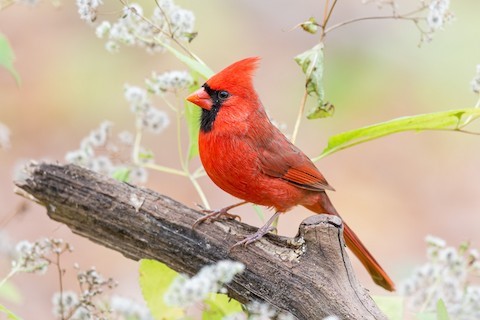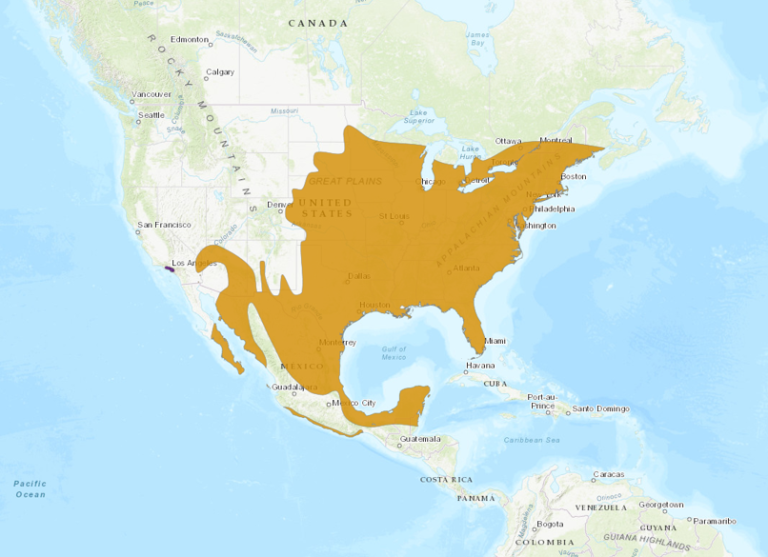Birdfinding.info ⇒ Among the most familiar North American birds, the Northern Cardinal has been adopted as the mascot of sports teams including St. Louis’s major league baseball franchise. It is generally abundant and conspicuous in gardens, parks, and woodlands throughout the eastern U.S. from the Great Plains to the Atlantic, locally in the Southwest and Mexico, and throughout Hawaii. Regularly nests in backyards and attends bird feeders.
Northern Cardinal
Cardinalis cardinalis
Eastern North America and Mexico.
Inhabits a wide variety of wooded and semiopen habitats, including agricultural and urban areas, from eastern South Dakota and Minnesota east through the Great Lakes to the Gaspé Peninsula, P.E.I., and Nova Scotia, south throughout the central and eastern U.S. into Mexico. Also resident from central Arizona and southwestern New Mexico southward.
In Mexico, occupies several distinct regions: Baja California Sur; the Trés Marías Islands; the Sonoran Desert; the central plateau south to northern Michoacán and Mexico City; the Pacific lowlands from Sonora to the Isthmus of Tehuantepec; the Gulf lowlands south to eastern Oaxaca; and the Yucatán Peninsula, including the Petén of Guatemala and northern Belize.
The southern Pacific lowland populations, carneus—occurring from around Colima east to the Isthmus—are sometimes recognized as a distinct form, the “Long-crested Cardinal”.
Occasionally wanders west and north of its usual range to the interior western states, the Prairie Provinces, and Newfoundland.
Introduced populations are well-established on Bermuda, along the southern California coast from Los Angeles to Chula Vista, and on all the main Hawaiian Islands.
A small population reported from the Swan Islands of Honduras since 1996 is thought to be introduced.

Breeding Bird Survey Abundance Map: Northern Cardinal. U.S. Geological Survey 2015
Identification
Male is unique and unmistakable: a large, long-tailed all-red songbird with a tall peaked crest, black face, and large, triangular, coral-red bill.
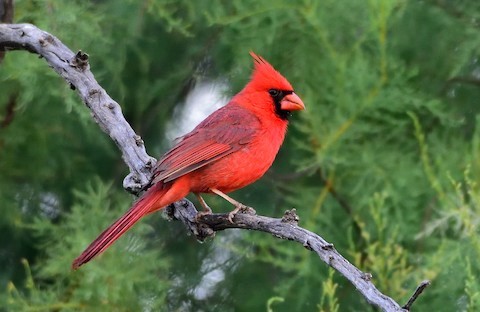
Northern Cardinal, male. (Rio Bosque Park, El Paso, Texas; May 15, 2020.) © Ad Konings
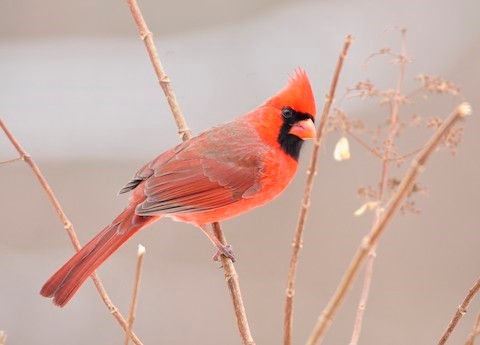
Northern Cardinal, male. (Greenwich, Connecticut; February 20, 2021.) © Oliver Patrick

Northern Cardinal, male. (Cornwall, Vermont; March 20, 2021.) © David Guertin
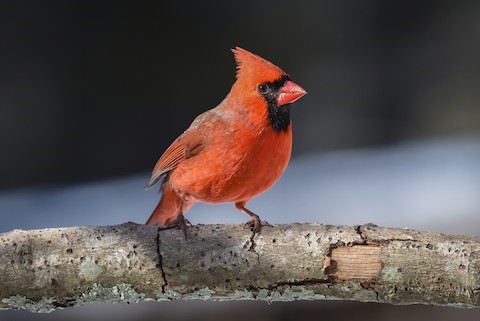
Northern Cardinal, male. (Dartmouth, Massachusetts; March 12, 2017.) © Scott Martin
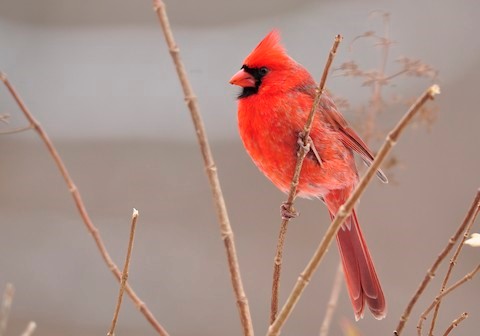
Northern Cardinal. (Greenwich, Connecticut; February 20, 2021.) © Oliver Patrick

Northern Cardinal, male. (Blue Ridge Landfill, Franklin County, Pennsylvania; February 5, 2021.) © Jefferson Shank

Northern Cardinal, male. (Terra Woods, Ohio; February 7, 2021.) © Jeff Peters
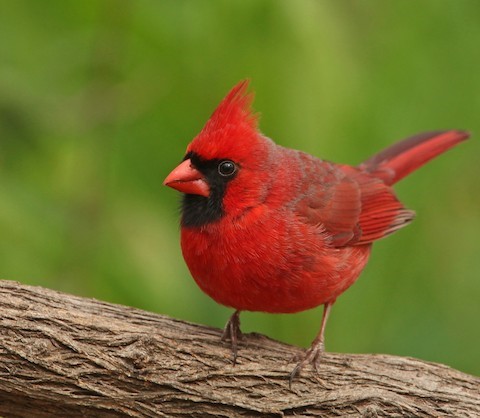
Northern Cardinal, male. (Cape May, New Jersey; April 23, 2017.) © Christophe Buidin
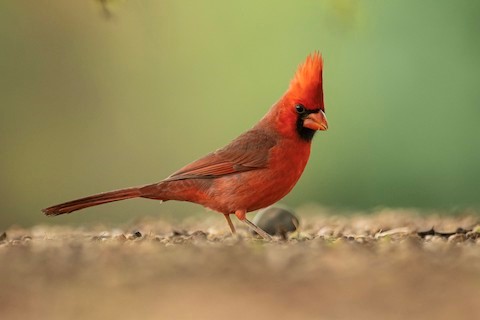
Northern Cardinal, male. (Riparian Preserve at Gilbert Water Ranch, Gilbert, Arizona; December 8, 2019.) © Neil Rucker
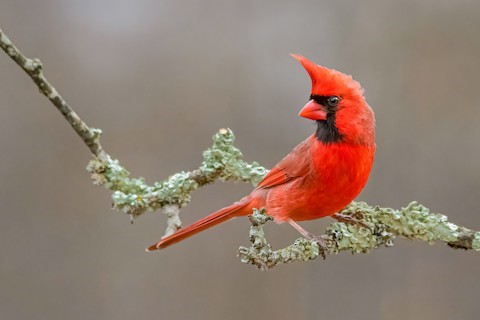
Northern Cardinal, male. (Newark, Ohio; December 22, 2020.) © Matthew Plante
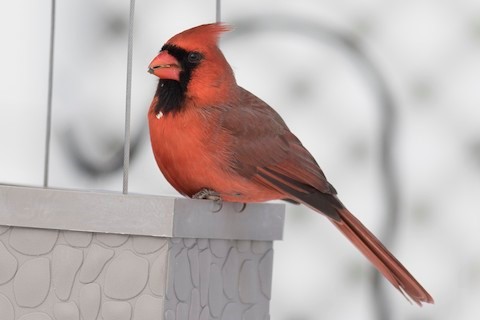
Northern Cardinal, male at the dull end of the spectrum. (Montoursville, Pennsylvania; December 15, 2016.) © David Brown
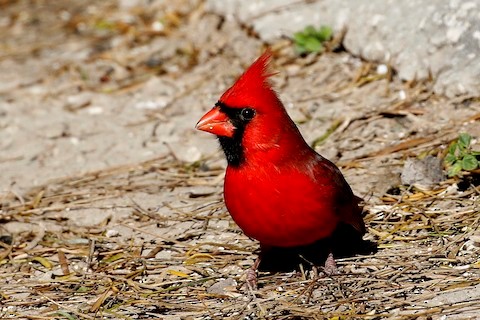
Northern Cardinal, male. (Hazel Bazemore County Park, Corpus Christi, Texas; December 30, 2019.) © Ted Keyel
“Long-crested Cardinal”. The Mexican Pacific subspecies carneus is sometimes considered a distinct form or even a separate species. It appears to be effectively indistinguishable both vocally and visually except that its crest averages somewhat longer. (Crest length varies within and among other cardinal populations, and it is not clear that carneus differs substantially.)
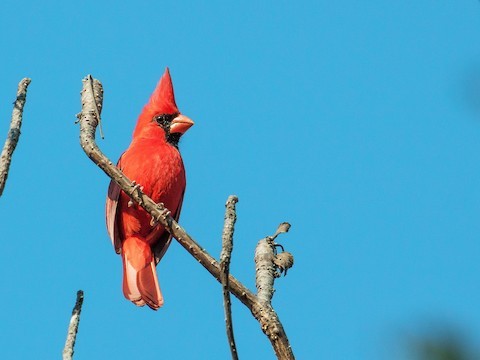
“Long-crested Cardinal”, C. c. carneus, male. (Zipolite, Oaxaca, Mexico; March 8, 2009.) © Nick Athanas
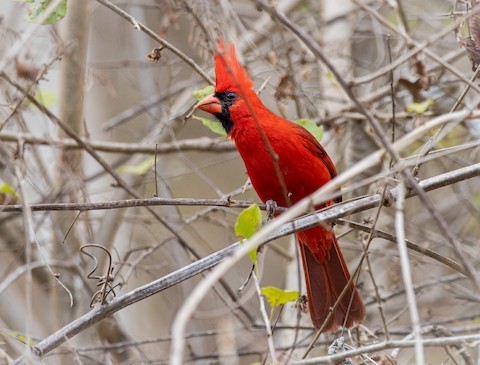
“Long-crested Cardinal”, C. c. carneus, male. (Sendero Cruz del Monte, Huatulco National Park, Oaxaca, Mexico; March 23, 2020.) © Alex Luna
Females resemble males, including the face and bill, but are predominantly pale-brown overall—varying from buffy to grayish—with dark reddish-brown wings and tail, red in the crest, and a variable pinkish flush elsewhere on the head and body.
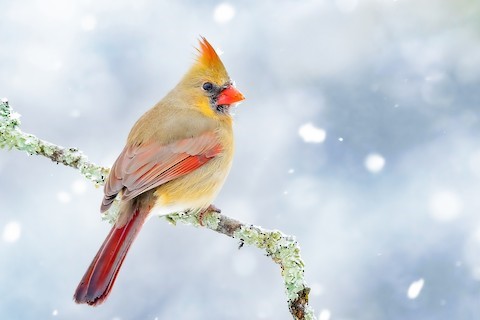
Northern Cardinal., female with unusually bright buffy and red plumage. (Newark, Ohio; February 16, 2021.) © Matthew Plante
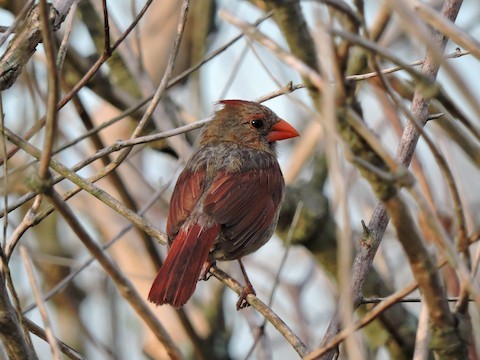
Northern Cardinal, female with fully-red wings. (Lake Apopka Wildlife Drive, Apopka, Florida; June 25, 2016.) © S.K. Jones
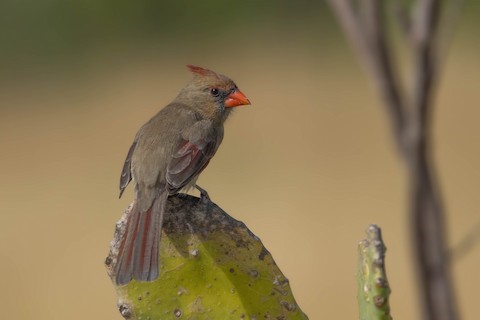
Northern Cardinal, female showing limited reddish coloration in wings and tail. (Palmview South, Texas; December 21, 2020.) © Peggy Rudman
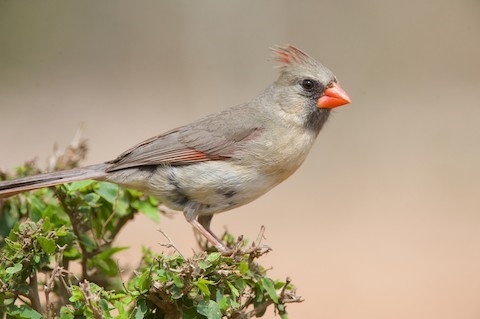
Northern Cardinal, female with mostly plain plumage. (Santa Clara Ranch, Starr County, Texas; April 25, 2013.) © Cliff Peterson

Northern Cardinal, female with mostly grayish body plumage and deep red on the wings and tail. (Lake Arrowhead State Park, Texas; March 20, 2018.) © Marvin Elliott
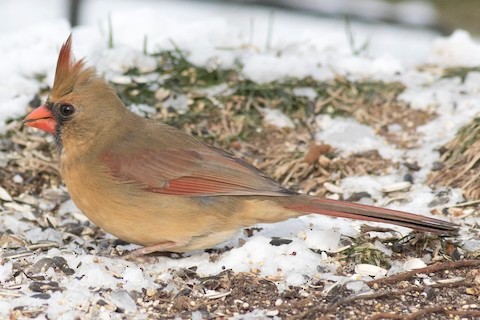
Northern Cardinal, female. (Montoursville, Pennsylvania; December 15, 2016.) © David Brown
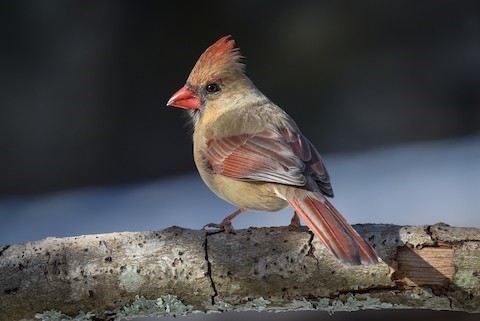
Northern Cardinal, female. (Dartmouth, Massachusetts; March 12, 2017.) © Scott Martin
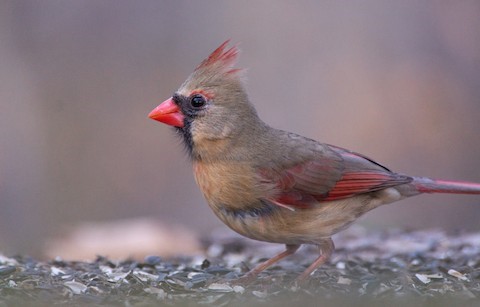
Northern Cardinal, female. (Chesapeake Beach, Maryland; March 6, 2021.) © Eaton Ekarintaragun
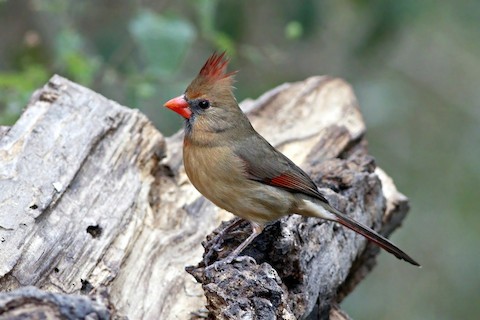
Northern Cardinal, female with mostly grayish body plumage and deep red on the wings, tail, and crest. (Estero Llano Grande State Park, Texas; January 1, 2021.) © Stephen Cook
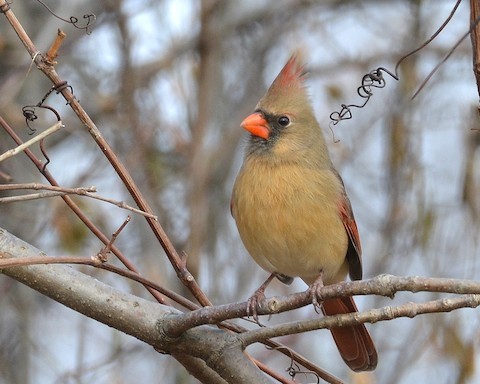
Northern Cardinal, female. (Fayette, New York; December 2, 2017.) © David Kennedy
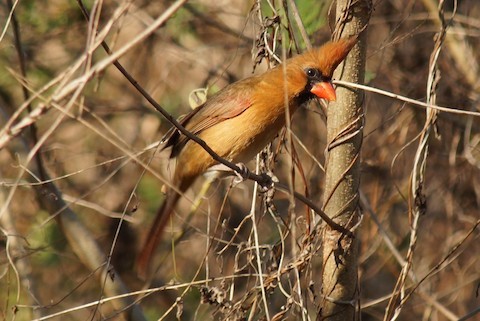
“Long-crested Cardinal”, C. c. carneus, female showing long crest and mostly buffy plumage. (Zihuatanejo de Azueta, Guerrero, Mexico; February 21, 2018.) © Robin Oxley

Northern Cardinal, female with pale plumage and pale pinkish bill. (Crescent Bend Nature Park, Cibolo, Texas; January 29, 2018.) © Mike Stewart

Northern Cardinal, female. (Eagle Creek Park, Indianapolis, Indiana; December 8, 2019.) © Ryan Sanderson
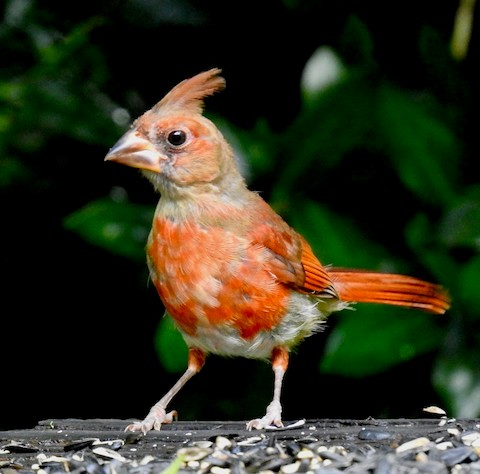
Northern Cardinal, immature male molting into adult plumage. (St. Gabriel, Louisiana; July 30, 2019.) © Van Remsen
Juveniles resemble females, but lack the black mask and have a dull dark bill.
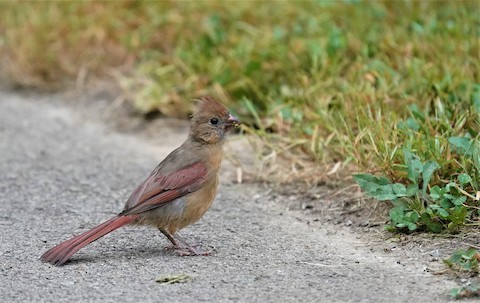
Northern Cardinal, immature. (Anchorage, Kentucky; September 26, 2020.) © Sunil Thirkannad
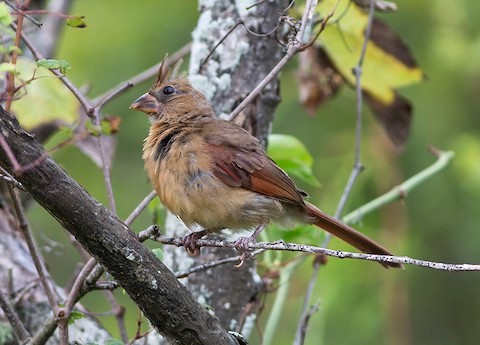
Northern Cardinal, immature. (Fort Macon State Park, Atlantic Beach, North Carolina; August 10, 2017.) © Martin Wall
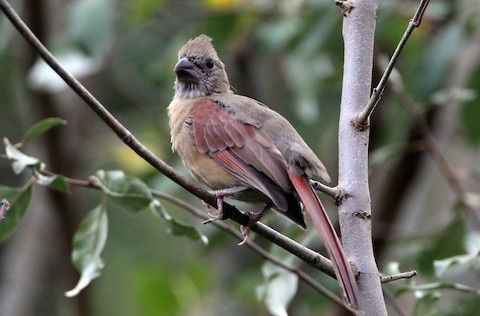
Northern Cardinal, immature. (Chalco Hill Recreation Area, Sarpy County, Nebraska; September 24, 2017.) © Elizabeth Winter

Northern Cardinal, immature. (Waves, North Carolina; August 31, 2017.) © Karen Lebing

Northern Cardinal, immature male molting into adult plumage. (St. Gabriel, Louisiana; July 30, 2019.) © Van Remsen
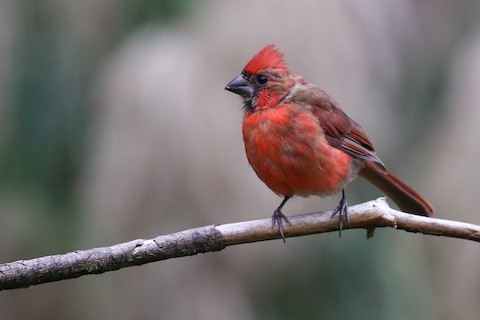
Northern Cardinal, immature male molting into adult plumage. (Indian Trail, North Carolina; September 25, 2020.) © Martina Nordstrand
Cf. Pyrrhuloxia. The Northern Cardinal occurs throughout the range of its close relative, the Pyrrhuloxia, which causes some confusion because the Pyrrhuloxia generally resembles a female cardinal. Male Pyrrhuloxias show a strong contrast between mostly gray plumage and vivid-red wings, tail, crest, face, and mid-belly. Female Pyrrhuloxias have less contrasting coloration and are more similar to female cardinals.
The most objective differences are in the bill color and shape. The Pyrrhuloxia’s bill is yellow and comparatively short and rounded. The cardinal’s bill is red, orange, or pinkish, and comparatively long and triangular.
Notes
Polytypic species consisting of eighteen recognized subspecies.
References
Alderfer, J., and J.L. Dunn. 2014. National Geographic Complete Birds of North America (Second Edition). National Geographic Society, Washington, D.C.
BirdLife International. 2018. Cardinalis cardinalis. The IUCN Red List of Threatened Species 2018: e.T22723819A132024136. https://dx.doi.org/10.2305/IUCN.UK.2018-2.RLTS.T22723819A132024136.en. (Accessed April 23, 2021.)
eBird. 2021. eBird: An online database of bird distribution and abundance. Cornell Lab of Ornithology, Ithaca, N.Y. http://www.ebird.org. (Accessed April 23, 2021.)
Howell, S.N.G., and S. Webb. 1995. A Guide to the Birds of Mexico and Northern Central America. Oxford University Press.
Kirwan, G.M., A. Levesque, M. Oberle, and C.J. Sharpe. 2019. Birds of the West Indies. Lynx Edicions, Barcelona.
Sibley, D.A. 2000. The Sibley Guide to Birds. Alfred A. Knopf. New York.
Xeno-Canto. 2021. Northern Cardinal – Cardinalis cardinalis. https://www.xeno-canto.org/species/Cardinalis-cardinalis. (Accessed April 23, 2021.)
